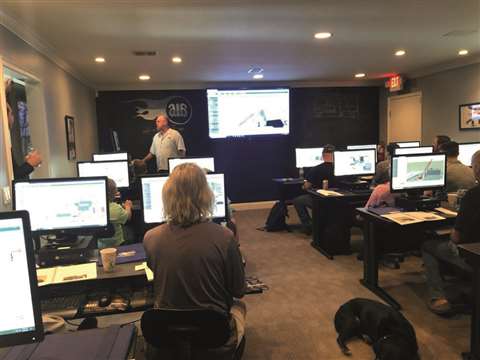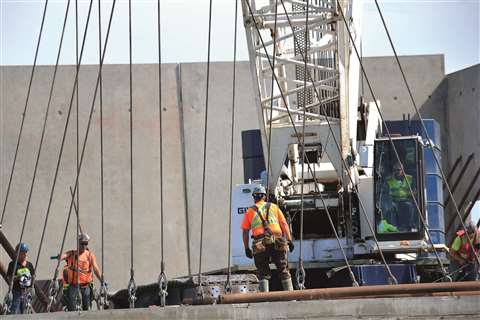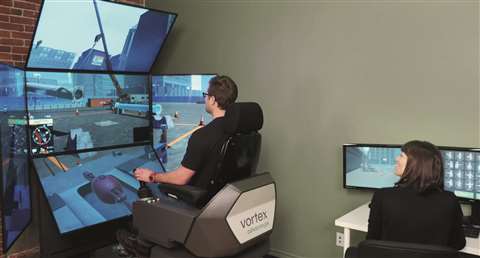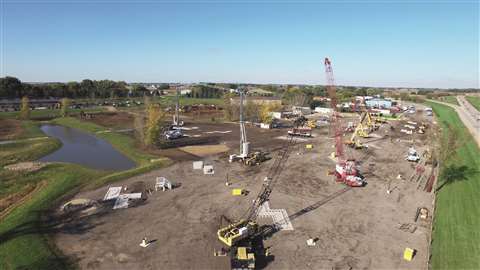Talent show: operator training
22 May 2020

Attracting talent and effective training are key to solving the construction industry’s skill shortage; fortunately there are plenty of training organisations offering their services. Christian Shelton reports.
The construction industry around the world is suffering a skills shortage. According to UK-based health and safety training company 3B Training the UK construction industry, for example, is facing its biggest skills shortage since 2007. It cites the Royal Institute of Chartered Surveyors (RICS) which claims that more than 200,000 skilled workers are needed by the mid-2020s. The industry is also suffering from an aging workforce notes 3B Training. It says that data from the 2011 UK census showed that one in five employees in the construction industry were aged over 55. This, it says, means that by 2020 the industry will lose a fifth of its workforce to retirement. And that’s just in the UK alone; a similar story is reflected around the globe. So how do we replace these skilled workers? The first step is attracting new talent, followed closely by effectively training them.
In the USA, industry-led initiative Lift and Move aims to attract new talent by promoting careers in the crane, rigging and specialized transport industry. It does so via events around the country hosted by key industry players showcasing the opportunities a career in these areas can bring. Lift and Move focuses on school and college students as well as military veterans as its primary area for recruitment. Generating interest early is important, iterates 3B Training. “If companies shout about some of the amazing roles in the industry, they’ll have a much better chance of engaging with young people who are looking for an exciting career path,” says Ryan Latham, senior marketing executive for 3B Training.
Lift and Move’s focus on attracting military veterans is mirrored by the Lifting Equipment Engineers Association (LEEA) – a representative body for all those involved in the lifting industry worldwide. “A major theme through a military person’s career is: ‘you are always being trained or training the new incumbent’,” says Baz Trewhella, training manager at LEEA as he explains why he thinks veterans make good construction workers. “This makes a military person very capable of adaptation in most given situations because they are always learning. They are also very proficient at falling back on previous knowledge and skill and applying it to good effect when it is most needed.
“The skill set, the mindset, the ‘can do’ attitude and a set of life skills second-to-none means ex-forces personnel make good workers. They are disciplined, punctual, loyal and committed to every undertaking. The only aspect open for consideration is training the service person/veteran into the commercial way of life thinking and the specific skills needed for a particular role.
USA-based vocational training provider Associated Training Services (ATS) prides itself on its veteran-friendly status. ATS offers a variety of training programmes in heavy equipment operation, mobile cranes, lattice boom cranes, tower cranes, articulated boom cranes, digger derricks, construction related trucks, rigging, signalling, horizontal directional drilling, and commercial motor vehicles.
“We are strongly committed to helping veterans start careers in the industries we train for,” says John Klabacka, president at ATS. “The majority of our clientele are individual consumers who come from across the country to attend our beginner level training programmes for heavy equipment and crane operation. We train approximately 1,000 of this type of student each year, a third of these are veterans and most of them have just recently ended their term with the military. Because these students come from across the country, our school provides housing, and for veterans. We provide this housing at no cost. After our students graduate, we assist them in finding employment in their community of residence.”
ATS offers both standardised programmes as well as customer specific specialised training and employs over 50 people at its 50 acre location in Sun Prairie, Wisconsin, where the business began in 1959. This staff includes 25 full time instructors and 12 of these instructors are certified NCCCO practical examiners. ATS also owns a fleet of over 100 pieces of heavy equipment, cranes, and trucks. ATS has been affiliated with the National Commission for the Certification of Crane Operators (NCCCO) since 2007. Over the last 12 years, ATS says it has helped roughly 10,000 candidates acquire NCCCO certification.

International standards
On an international level, LEEA believes establishing universally high standards is important. “Gravity doesn’t recognise different countries, languages or legislation,” says Ross Moloney, CEO of LEEA. “It’s the same wherever you are in the world and, in this sense, ours is perhaps the most globalised of all industries. Ensuring that everyone working in the industry is safe and goes home at night is our vision.
“We are striving to set a global minimum benchmark for safety through standardisation which creates a level playing field for all involved with lifting equipment and ensures that the risks associated with lifting operations are lowered to an acceptable minimum for all.”
In Canada, Vancouver-based organisation BC Association for Crane Safety (BC Crane Safety) is responsible for the overall administration of crane operator certification in the state of British Columbia. The organisation says it provides leadership for health and safety development within the crane hoisting industry, serves as an advisory body on regulatory and safety matters, works with industry, labour and government to develop and implement new standards of assessment and certification, and provides leadership in the establishment, maintenance and support of industry specific assessment tools which result in a BC Crane Operator designation. BC Crane Safety is responsible for managing certifications, evaluations and setting standards of three types of crane operators: boom truck, mobile and tower crane operators. The crane operator certification regime, which was initiated in 2004, is the culmination of consultation with industry representatives and the provincial regulator and resulted in the launch of the provincial crane operator programme in 2009. To receive a certificate, an operator must pass a skills assessment relating to the type of crane that they currently operate or wish to operate in the future. To date, nearly 11,000 operators have been registered within the programme, with nearly 10,000 operators being full scope certified or are in the Credential Recognition programme (journey persons or apprentices). The other 900+ individuals have provisional (limited scope) certification, explains BC Crane Safety.
Uniform international standards will take a step closer to fruition from April 2020 when a memorandum of understanding will be officially signed in Amsterdam for mutual recognition between BC Crane Safety crane operator licences and ESTA’s ECOL (European Crane Operator Licence) programme. The agreement means that an ECOL licence and a BCACS licence will be interchangeable and operators holding them will be able to work in both territories. “This is very good news indeed and shows the growing international interest in ECOL and how it can both improve safety and employment flexibility, allowing good operators to work wherever they are needed,” says ESTA director Ton Klijn. For more about ECOL see the ESTA news update on page 55.

Training technology
Within the USA, in order to maximise its reach, training provider All Purpose Crane Training provides FED OSHA nationally recognised accredited mobile crane operator certification and training in-house on-site in 50 states. To help further attract talent the company can conduct training in English or Spanish. The company points out that the current state of crane industry rules is changing dramatically along with OSHA related compliance certification deadlines. Predicting the future for the crane industry is nearly impossible, it says, with today’s lifting technology continually developing.
As lifting technology develops, however, so too does training technology. In addition to providing onsite training anywhere in the United States, All Purpose Crane Training offers online crane and rigging training for small and large telescopic lattice boom crawler and truck mounted cranes. The advantages of online training, it says, include the simplicity of qualifying personnel in-house, with the added benefit of having online training records that are available 24/7 in case proof and verification of training is ever required. The online course also means that students can learn at their own pace. The use of video, graphics, and animation are designed to keep users engaged and focussed and are particularly effective in training the tech-savvy young people that are required to stop the current skills shortage.
Another company embracing technology for training purposes is Florida, USA-based A1A Software. One of its key products is its lift planning software, 3D Lift Plan. A1A Software provides training in the program in the form of one-day courses, six annual three-day intensive boot camps and online training. The online training comprises daily seminars that provide basic, advanced and feature-specific training in the lift planning software. Many of the classes are free and being brief, are easy to fit into a daily schedule, the company says. Students can also listen to an instructor and watch on the screen as they use the software to build lift plans.
Quebec, Canada-based company CM Labs utilises simulator technology for training purposes via its Vortex simulators, which have helped train crane and heavy equipment operators around the world. CM Labs claims to be the largest simulator vendor in the market, with over 1,000 simulators in 30 countries deployed with Vortex software. CM Labs say its Vortex simulators provide immersive, ultra-realistic learning environments that promote increased safety and operational efficiency, essential skills development, and reduced training costs.
The company’s latest simulator development is a feature called the Instructor Operating Station (IOS) which allows trainers to launch and monitor simulator training exercises. This means instructors can make changes to training scenarios on the fly, such as adding different objects to the worksite and changing the position of vehicles. Exercises can also be tailored to individual trainee’s abilities for more efficient learning. “Instructors now have access to a virtually unlimited number of simulation exercises for any given piece of equipment,” says Drew Carruthers, CM Labs’ director of product strategy. This is made possible due to the simulation software utilised by the IOS. According to CM Labs this software, Vortex Studio, is designed to realistically simulate mechanical equipment and their operating environments, whether for training, or for engineering and prototyping applications.
CM Labs claims that, in addition to allowing trainees to experience conditions that are too risky to replicate in real life, simulated training provides an effective method for training because, using real-time data, trainers can receive feedback on an operator’s performance as it happens, creating opportunities to re-shape bad habits before they form.
The company also highlights developments in simulated training where teams can work together in a connected simulated environment — multiple crane operators, riggers, and even site personnel. Simulator equipment is becoming more mobile and less expensive, says CM Labs, and is now coming integrated with the latest technology that’s found on the real equipment, such as GPS guidance. Other features include trainee scoring and reporting that make it easier for operators to learn how to improve more quickly.
CM Labs says that while simulation training has traditionally been considered to deliver a jobsite experience in a classroom, it claims that as augmented reality (AR) becomes more widely adopted there are also opportunities for improving on-the-job training. It illustrates the point with the example of overlaying a digital lift plan for a crane using AR to make sure the plan matches the current job site conditions. By using AR glasses to superimpose digital information on the environment, an equipment operator can train on site hazards and setup procedures, shift start-up equipment inspection or machine troubleshooting, or even practice an operation before starting up the equipment, CM Labs says.

Leading the way
Crane Industry Services (CIS) is a USA based training company that utilises CM Labs’ Vortex simulators. “Simulators are an efficient and effective way to train that reduces seat time for refreshing skills and training novices to be qualified operators,” says Debbie Dickinson, CEO, Crane Industry Services. She recognises, however, that crane, rigging, and construction trades need more from their trainers today than in the past. The demand for skills development is high, she claims, and current, relevant workplace experience, tech savvy training and direct application to the work are essential. In addition, employers are also looking for trainers to assist with workforce development – recruiting, screening and qualifying workers, Dickinson adds.
Recognising this, CIS has developed, in partnership with business and people strategies consultant Okos, a programme to train construction and utilities leaders in how to engage teams in workplace safety. The programme Leading Safety Works uses coaching, storytelling, and case-study applications, CIS says. According to Dickinson it includes practical tools to help leaders learn how to make critical connections between project and people strategies, how to identify opportunities to change and improve safety practices, how to involve teams in decisions and communications, and how to create accountability. One of those tools is NCCER Instructor Certification Training. The programme is designed to teach managers and skilled craft professionals how to teach others, to assess progress, qualify workers, and document trainees’ abilities. “Skilled crane operators and riggers are not necessarily good at passing their knowledge along, but with the right training, they can learn to become instructors, curriculum developers, motivators, and assessment experts,” says Dickinson.
The push for training has also shifted the focus of many companies to be more aware of the necessity of safety training and operator evaluations, says USA-based training school Cranes101. The company has developed a programme designed to teach operators how to safely inspect, maintain, and record equipment maintenance and safety utilising classroom and hands-on training, with a concentrated look on safety regulations as they pertain to the industry, says Cranes101. The company also offers its training online. It says its online portal is easy to use, and offers advanced options such as administrative control, progress tracking, and virtual classroom assignments. The portal also stores certificates virtually which can be printed if required.
With so many training services available, selecting the right trainer, or the right training method, can be daunting. “As with all industries, consumers should be diligent when deciding who to work with,” advises Klabacka (ATS). Consideration must also be given to the most effective training method undertaken. “In the last three to five years we are seeing more companies steering towards the use of virtual reality simulator systems to train the crane operators,” illustrates Crews. “There are many different comments, reviews and opinions on how effective and true to real life crane operations virtual reality is for the operator… it varies from operator to operator whether it is really effective.”
We leave the final words to Denise Almonte, owner of Illinois, USA-based training organisation Safety First, Compliance Training. who advises, “Find a trainer who has been ‘field tested’,” she advises, “one who knows your applications, is experienced in how you work, the equipment you use and the language you use. Try and find a trainer who has walked the worksite and is familiar with all possible hazards!”




